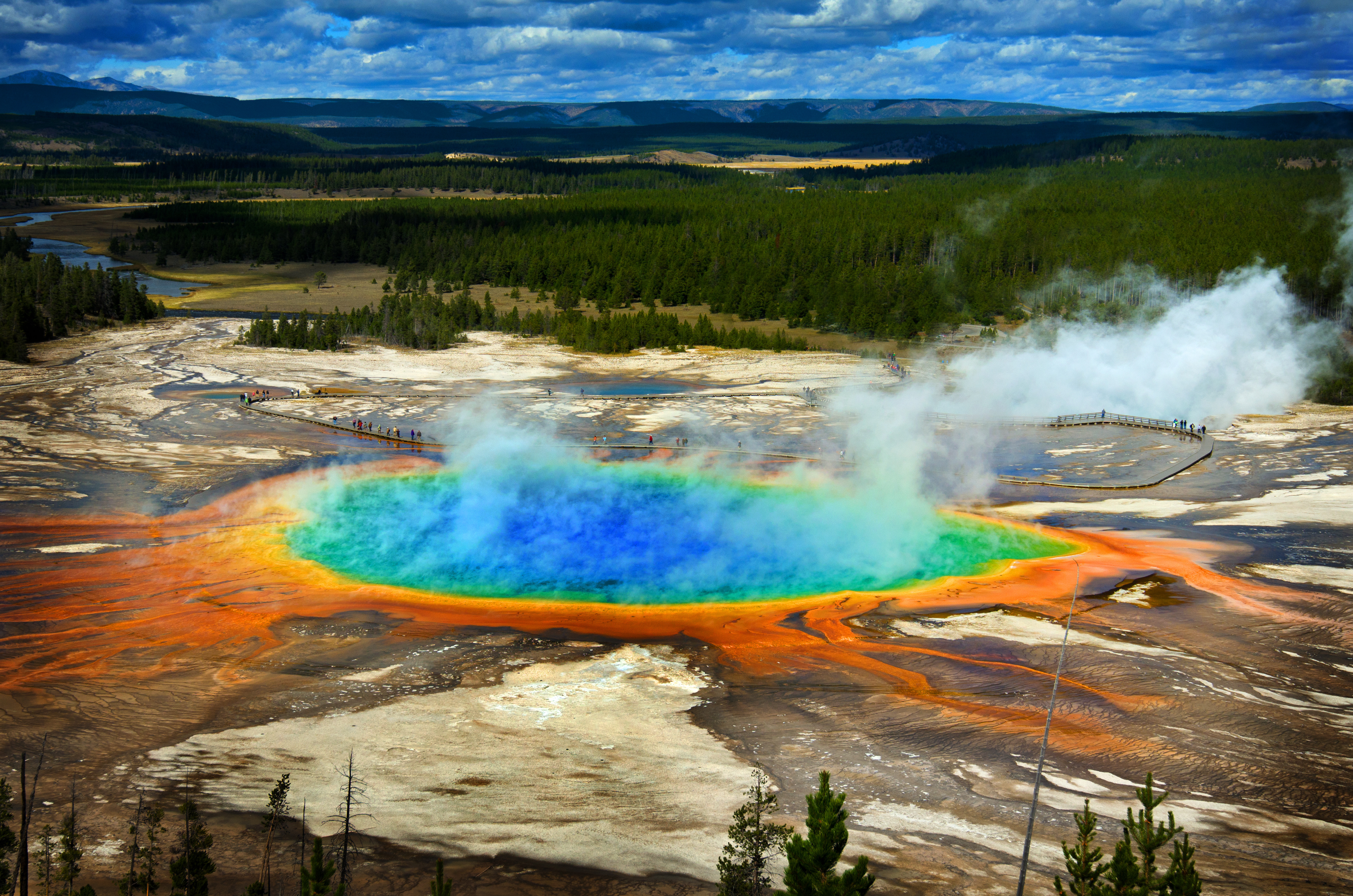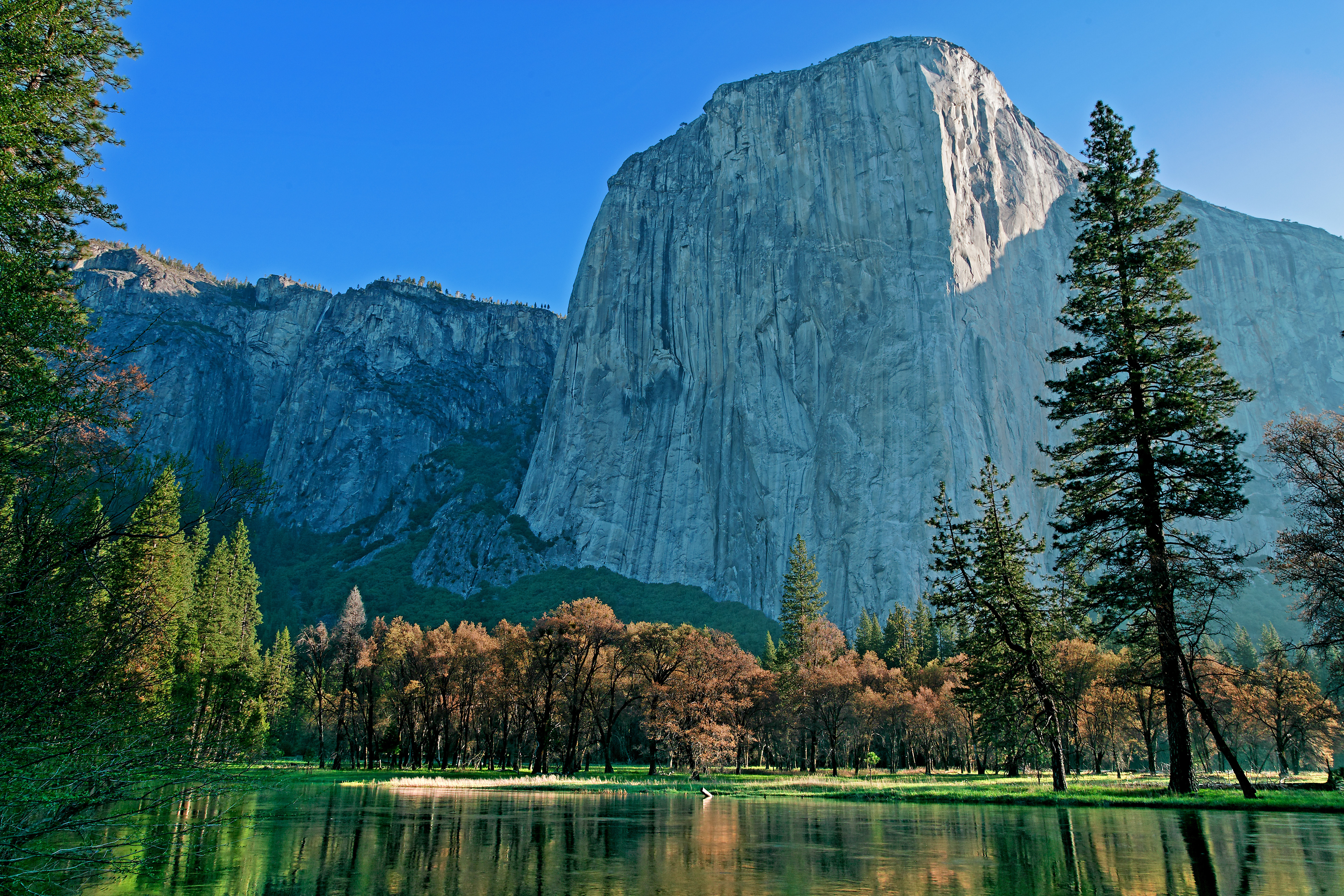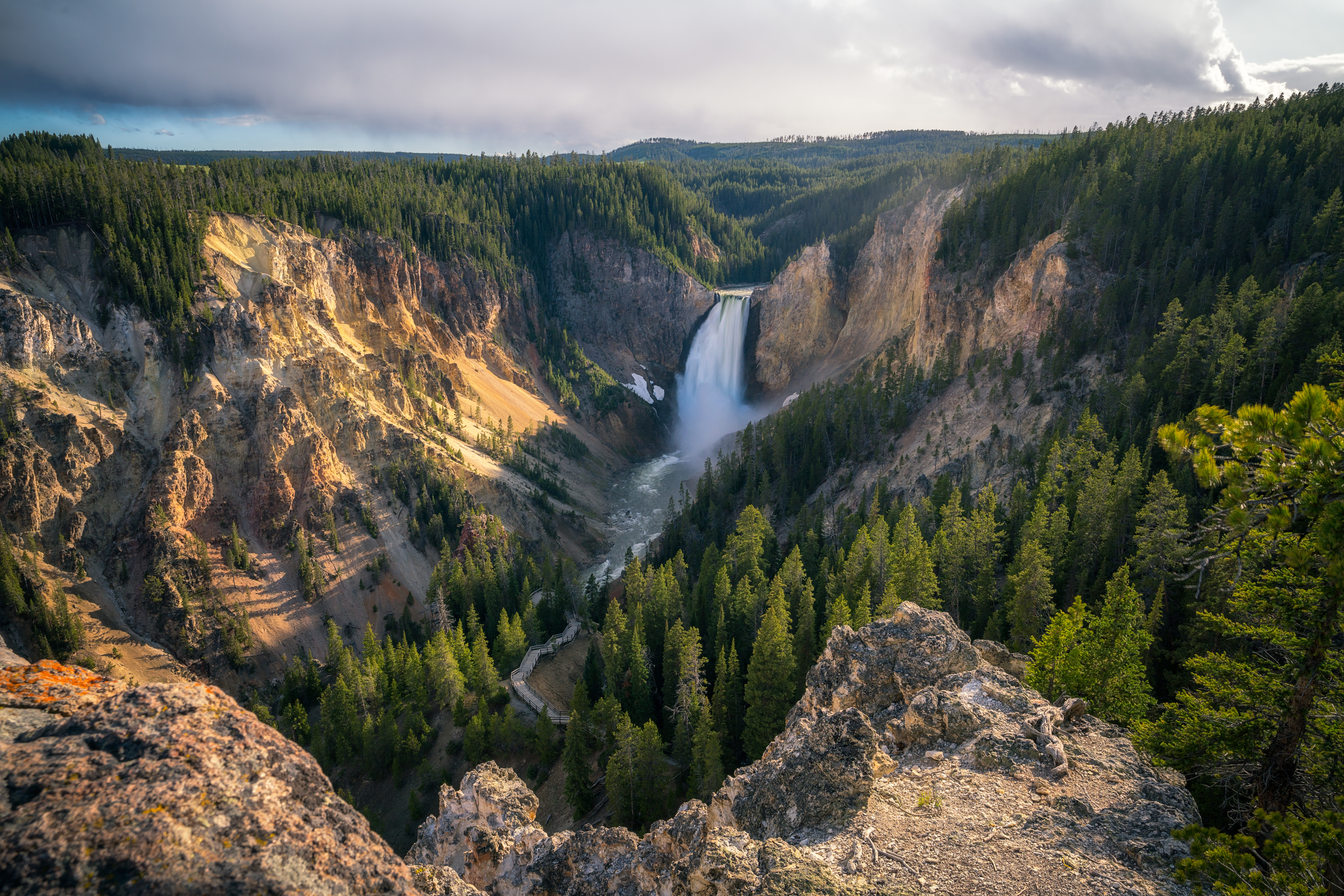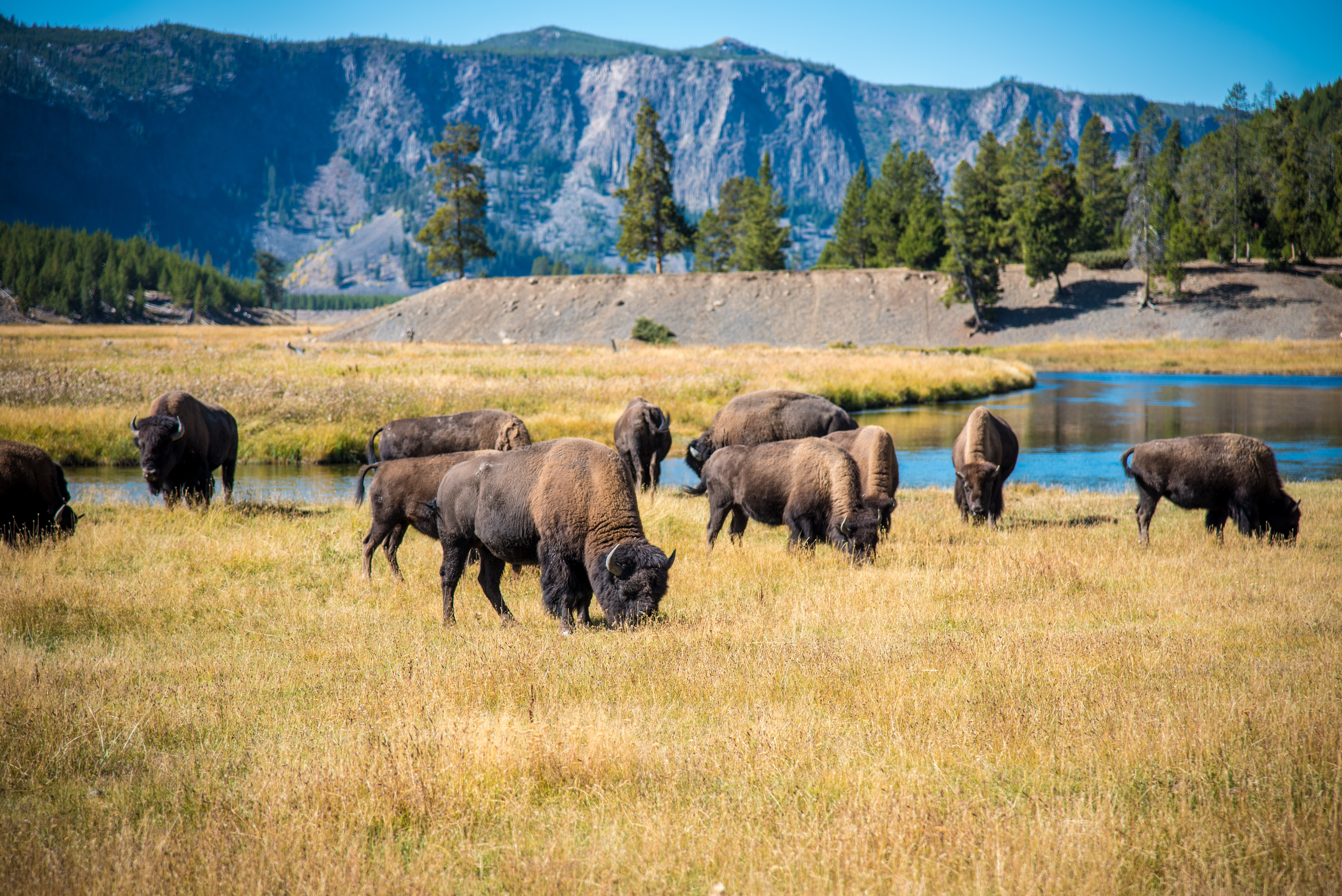How To Plan A Trip To Yellowstone
Yellowstone is America’s most iconic national park, which means that planning a memorable trip to Yellowstone takes time and patience. It also requires the ability to make some hard choices, because at heart, Yellowstone is a wilderness that’s adjacent to a heavily touristed road.
If you stay on the road you see the popular sights and likely a lot of wildlife, but you miss the majority of the park and many of its most amazing natural wonders.
To what extent you get off the road plays a big part in determining how heavily planned your trip needs to be. Which is where this guide comes in handy!

Yellowstone – the lay of the land
Yellowstone sits where Montana, Wyoming and Idaho meet. It’s surrounded by other protected land – the Custer Gallatin, Shoshone, Caribou-Targhee, and Bridger-Teton national forests, as well as Grand Teton National Park – with scattered patches of private land that have been developed into hotels, resorts, and other touristy stuff.
However, Yellowstone is not America’s most popular national park – not even close.
Yellowstone attracts more than 3 million visitors a year, according to USA Today – a whopping 10 million less than the Great Smoky Mountains, which benefits from its proximity to the populous east.
Yellowstone’s 3 million is also less than the number of visitors to Rocky Mountain, Grand Canyon, Zion, or Yosemite national parks.
It may not feel that way, though, since the majority of Yellowstone’s visitors drive on one road – the Grand Loop Road, a 142-mile-long route traversing Yellowstone’s major attractions, which include:
- The Grand Canyon of the Yellowstone
- Mammoth Hot Springs
- The world-famous Old Faithful
- Yellowstone Lake
The other road-well-traveled is the Beartooth Highway (U.S. 212), which enters the park’s northeast corner and winds through alpine evergreen forests and alpine peaks before terminating at Tower Junction, where it hooks up with the Grand Loop Road.
Just off these roads are picnic and camping areas and trailheads, in addition to visitor centers and the big attractions like Old Faithful.
Further off the roads are trails that lead back into truly wild areas teeming with moose, bear, buffalo, elk, eagles, and more.
If you want to explore those areas, you’ll need to do some planning.
Deciding whether (and how) to explore the backcountry
To rough it or not to rough it – that’s the question.
Going into the backcountry means you leave your vehicle behind, but it doesn’t mean you have to go on foot … and it doesn’t necessarily mean leaving creature comforts behind.
The park licenses vendors like Yellowstone Outfitters to conduct backcountry tours using boats, bikes, snowmobiles, horses, mules, or llamas (!).
When you go on a tour with an outfitter, your camping and food are generally taken care of. All you have to do is watch the incredible scenery go by and pitch in when asked.
If the cost of an outfitter or other factors send you in a different direction, you have options.
Camping and permits
Yellowstone has 293 backcountry campsites that are generally reserved for groups of four to 12 people for a maximum of three nights.
Each site comes with a food-storage pole (which requires you to bring a rope 35 feet or longer) or box to keep your breakfast from becoming a bear’s dinner.
If backcountry camping sounds like your kind of thing, you’ll need a permit, which doubles as a campsite reservation.
Here are some other things you need to know about camping in Yellowstone:
- During peak season (May 15-Oct. 31), permits are available at Recreation.gov via an early-access lottery and general on-sale period, with a quarter of campsite reservations available for walk-up campers at a backcountry office.
- During the off-season (Nov. 1-May 14), permits are available at Recreation.gov starting Oct. 6, or at the South Entrance mid-December to mid-March, but you need to contact the Central Backcountry Office for your permit and get a backcountry orientation.
Winter backcountry camping is its own more dangerous thing. Yellowstone’s Winter Backcountry Camping page has more information regarding obtaining a winter permit.
While this process seems like a lot, it’s necessary – and ultimately very affordable. The early-access lottery (recommended if you have trip dates in mind) costs $10 to enter, while campsites cost $5 per person per night plus a $10 reservation fee (plus whatever 35 feet of rope costs).

Deciding how much you want to drive
Unless you’re entering the park on horseback or snowmobile or taking a bus tour, chances are you’re going to be driving into the park. The question is, how far do you want to drive?
The website National Park Obsessed recommends you fly to an airport somewhere close, then rent a car and drive the rest of the way. The problem is, the nearby airports aren’t really all that near.
For instance:
- There is an airport at Yellowstone Park West that handles small commercial aircraft from Delta and SkyWest, but it’s only open in the summer.
- The Yellowstone airport in Cody, Wyo., offers more flight options, but in the winter it’s on the wrong side of the only open park entrance.
- The Jackson Hole airport is open year-round, but it doesn’t accept large planes and it’s an hour drive on some dicey roads.
Pushing further out, the airports in Montana’s three B’s – Bozeman, Billings, and Butte – are good options, with multiple flights from major carriers. Driving time from these to Yellowstone ranges from an hour and a half to two and a half hours.
Otherwise, the big airports in Boise and Salt Lake City require five to eight hours of driving to get to the park. That’s a lot of driving on roads that can quickly turn impassible.
Road-tripping
Many people in the Midwest, Southwest, and Far West see a trip to Yellowstone as one of America’s greatest road trips – and it can be, depending on how well the kids behave.
The park is:
- Eight hours from Denver
- 12 hours from Seattle and Portland
- 15 hours from Los Angeles, Phoenix and Minneapolis
- 18 hours from Kansas City
- 21 hours from Chicago
- 22 hours from Dallas
- 24 hours from Houston
For most of these trips, figure on at least one overnight stay and one long day of driving.
Also note that facilities can be limited on some of these routes. You’ll need to plan your stops.

Deciding how far away you want to stay
Yellowstone has reasonably good in-park accommodations – nine lodging facilities offering more than 2,000 rooms in the summer. Some are on the spartan side, some are expensive, and some have long waits for dinner. But you’re in a wild national park; roll with it.
On the other hand, many date from the early 20th century and have that rustic hunting-lodge look that can’t be duplicated.
Also, if you book a winter trip to Yellowstone (something Travel + Leisure highly recommends) note that only the Mammoth Hot Springs and Old Faithful Snow lodges remain open.
Outside the park you can choose from everything from plain motels to truly luxe lodges, with dude ranches and VRBOs in between.
There are no foolproof recommendations for choosing lodgings outside the park. Read reviews and choose what appeals to you within your budget.
Be sure to pick lodgings near an open entrance if you choose to stay outside the park. Of the park’s five entrances, only the North Entrance is open year-round.
Deciding if an alternate entrance is a good idea
Speaking of all those entrances, Yellowstone in the summer lets you enter from the:
- North (Gardiner, Mont., U.S. 89)
- South (Jackson, Wyo., U.S. 191)
- Northeast (Cooke City, Mont., U.S. 212)
- East (Cody, Wyo., U.S. 20)
- West (West Yellowstone, Mont., U.S. 20 and U.S. 191)
Each entrance has its own character:
- The northeast entrance is rugged and mountainous
- The east entrance has jagged peaks looming in the distance, and is furthest away from the most popular tourist spots
- The north entrance features the iconic Roosevelt Arch, and is closest to Mammoth Hot Springs
- The south entrance is heavily wooded, and is best for travelers coming up from Grand Teton National Park
- The west entrance is the most built-up, thanks to its proximity to West Yellowstone, and is closest to Old Faithful and Yellowstone Lake
Each entrance can get you to great scenery and amazing wildlife relatively quickly; where you enter has a lot to do with where you came from, the attractions you want to see, and which entrances are open.
Deciding how you want to handle the crowds
Yellowstone may not be the most popular national park, but it’s crowded enough.
Unlike many national parks, Yellowstone does not require a dated reservation. However, you need an entrance pass, and are encouraged to buy one ahead of time.
Standard day passes are $20-$35, depending on whether you’re walking ($20) or driving ($35). Annual park passes are $70 and all-park annual passes are $80 for people ages 16-62.
All-park passes are a screaming deal if you plan on visiting more than one national park (which, if you come up from Grand Teton Park through the south entrance, you’ll do automatically), especially if:
- You’re over 62 ($20 for an annual pass and $80 for a lifetime pass)
- Disabled (free)
- A veteran (free)
- Active military (free)
Buying passes ahead of time will save you time in line, but you can still expect backups at most entrances at peak hours on weekends and holidays.
The best advice for minimizing wait times is:
- Arrive early. The park never closes, but you really want to see the park in daylight. Also, most visitor centers open at 8 or 9 AM, so if you want to use a restroom or get information keep that in mind.
- Go during the week.
- Visit during non-peak times. The last two weeks of May and the first two weeks of October are wonderful times to visit.
Deciding if you want to get out of the car (you really should)
If all you do in Yellowstone is drive through the park, you’ve wasted an incredible opportunity.
The park is a place for you to interact with nature … so interact.
Yellowstone is a paradise for all hikers of all skill levels. AllTrails recommends the following easy hikes in West Yellowstone:
- Grand Prismatic Hot Spring
- Fairy Falls Trail
- Upper Geyser Basin
- West Thumb Geyser Basin Trail
- Midway Geyser Basin Trail
- Mystic Falls
- Canyon Rim South Trail to Artist Point
- Norris Geyser Basin Complete Loop Trail
Any of these hikes are going to show you so much more than you could ever see from behind a windshield.
With any hike, just remember to wear something better than flip-flops and take along a full water bottle, just in case.
Wildlife
You will likely see bear and buffalo in Yellowstone. Please remember they are wild animals and you are encroaching in their habitat. They are not pets, and they are not to be fed.
Expect the unexpected from these animals, and respect their power. Take all the pictures you want from a safe distance or from inside your car.
Also, lower your speed when wildlife are in the area.
To ensure you and Yellowstone’s wildlife get what you need from the park, read and take the Yellowstone Pledge before you leave. Most of it’s common sense – but you’d be amazed at the extent to which common sense goes by the wayside sometimes.
However you choose to explore Yellowstone, remember travel insurance from Berkshire Hathaway Travel Protection to protect your prepaid expenses. Plans like AdrenalineCare® are made for adventure travel.
If you decide on your degree of difficulty before you go and plan your trip accordingly you’re sure to have a great vacation in America’s most revered national park – even if you never get off the main road.
Questions About Travel Insurance?
Check out our online guide, "What Is Travel Insurance All About?" We've provided in-depth answers to all your travel insurance questions, starting with the basics.
